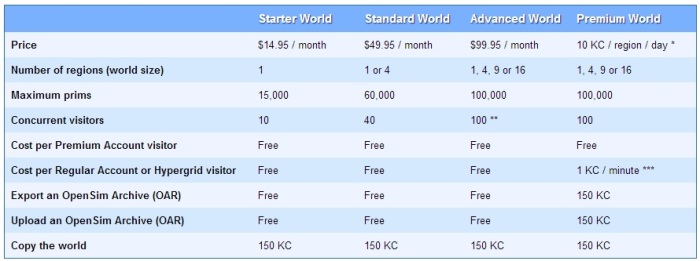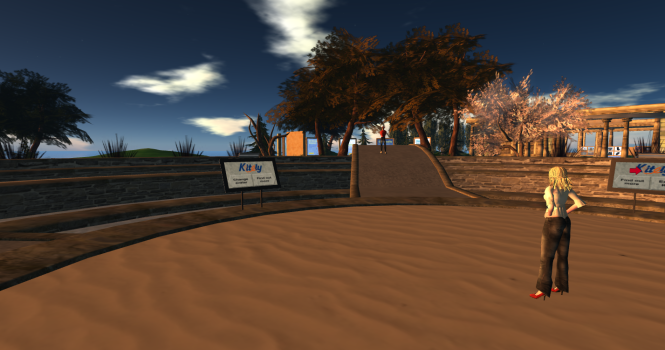Kitely‘s pricing options have long been a confusing mess for customers, with people having trouble understanding their metered billing in particular.
To address this issue, Kitely first rolled out flat-rate regions back in 2012, but the various pricing options just confused customers more.
It didn’t help that Kitely was the only grid in the metaverse renting regions based on how much they were used.
Over the next couple of years, Kitely continued to experiment with pricing, with each change adding yet more complexity.

Metered option going away on June 1
Starting next month, new customers coming to Kitely will only be able to rent fixed-price regions, the company announced today.
“This will make it a lot easier for people to compare what they get in Kitely with what they get elsewhere and thus see the benefit of using our services,” Kitely CEO Ilan Tochner told Hypergrid Business.
Other grids are currently renting out land at prices ranging from $3 per month for 15,000 prims — on SkyLife Grid — to $300 a month for 15,000 prims — on Second Life. Full price comparisons here.
These are all fixed-price regions. Customers pay a set amount each month, no matter how much their regions are used, or even if they’re not used at all.
Kitely’s fixed-price regions, while not the least expensive in the metaverse, do fall on the lower end of the price spectrum.
Currently, the least expensive option is $15 per month for 15,000 prims and up to 10 concurrent visitors.
It goes all the way up to $100 a month for 100,000 prims and up to 100 visitors — and the $100 region can be configured as a 16-region megaregion, which works out to about $6 per 6,250-prim region per month.
Kitely has a unique on-demand region hosting system where all the regions are hosted on the Amazon cloud, and are shut down when not in use.
If a region is not running when someone wants to teleport in, it can take from a few seconds to up to a minute to load it up. But otherwise, the on-demand regions function just about the same as regions on any other grid.

Existing customers grandfathered in
Since Kitely pays Amazon by the hour, it made some sense to charge customers that way, as well. Plus, metered pricing allowed some users to have a large number of regions for a low price.
For $20 a month for a “Premium Account,” for example, users could get up to five 100,000-prim regions, where the owner would get charged 1 KC per minute for every other person, besides themselves, using the region. That works out to between $0.20 and $0.30 per user per hour.
Beyond the five regions that came with the account, additional metered regions were between $1 and $1.50 a month each, plus the usage fees.
Except that there was no usage fee charged when the visitors themselves had premium accounts.
Existing customers with premium accounts can continue to use those accounts as long as they like, Tochner said. But if they discontinue them, they won’t be able to get them back.
In addition, starting now, the five regions that came with the $20 premium account will now be 10 regions for both new and existing customers. And the $35-a-month “Gold Plan” is back, which comes with 30 regions.
Customers who want either one of these plans will need to sign up before the end of the month.
Today, more than two-thirds of Kitely customers have a premium account, said Tochner. About a third have at least one fixed-price region, and some customers have both.
“Some people who have premium accounts opt to also get fixed-price worlds for their most popular worlds,” he said.
Although Kitely is a single OpenSim grid, with a common user registration system, inventories, and map, the company insists on referring to their regions as “worlds.”
Will it work?
According to Tochner, the existing pricing structure was scaring off new customers.
It also created a two-tier system of regions, where users without premium accounts could only access the fixed-price worlds, or those metered regions where the owners opted to pay for their visits.
Despite that, Kitely quickly grew to nearly 7,000 regions in size at last count, making it the largest commercial grid and third in land size after Virtual Worlds Grid and OSgrid.
In fact, the grid was regularly among the top region gainers in our monthly statistics report.
Meanwhile, Virtual Worlds Grid actually has just 800 regular regions and 72 giant, grid-owned, mega-regions each the size of 256 standard regions, and OSgrid allows anyone to connect home-based regions for free.
So Kitely is about to mess with a very successful formula.
Will the simpler-to-understand pricing structure make up for the loss of the low-cost metered regions?
Only time will tell.
Two things might help.
One is if they are able to reduce the start-up time of dormant regions to the point that people no longer notice a delay when they teleport in. That will eliminate the constant reminder that these regions are not up all the time — which, for some users, makes them not as good as always-on regions on other grids.
The other is if they are able to lower prices.
And that might well happen.
“Our fixed-price world options will be updated after the cutoff date,” said Tochner, but declined to provide any specifics, other than to say that the prices are not going up. “We’ll announce these new options once we start allowing people to order them.”
Bottom line
If you want to rent some fixed-price regions, and are currently deciding between Kitely and other grids, you might want to wait a month and see what their new price structure will be.
But if you need a lot of virtual land at the lowest possible cost, run out and rent Kitely’s metered regions now by signing up for either a premium or gold account. With the easy backups, they make great manufacturing and warehouse space for virtual content creators.
And they’re used for other activities, as well, said Tochner.
“Most of the worlds you see in the Explore Worlds page are Premium Worlds,” he said. “Even when people decide to allow non-Premium Account visitors to those worlds they often end up paying a lot less than they would have with a fixed-price world option. Premium Worlds allow up to 100,000 prims, 100 avatars and can be up to 16 regions in size. They are great value for most common usages — most OpenSim regions don’t get a lot of traffic so paying for time winds up costing significantly less than paying a fixed price per month.”
- OSgrid back online after extended maintenance - April 16, 2025
- Analysts predict drop in headset sales this year - March 25, 2025
- OSgrid enters immediate long-term maintenance - March 5, 2025
